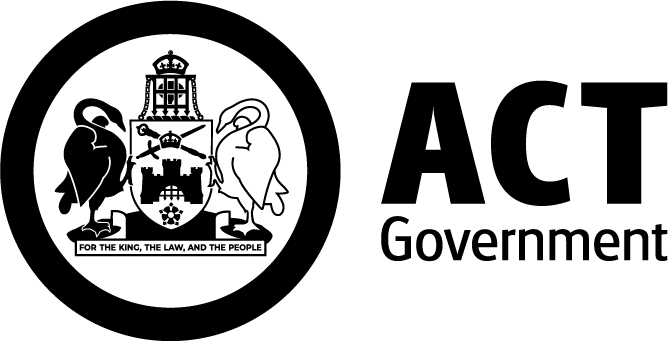Flags and emblems of the Australian Capital Territory (ACT)
The Australian Capital Territory (ACT) flag and emblems, and the City of Canberra Coat of Arms represent our shared history, environment, and cultural connections, particularly with the Ngunnawal people, the Traditional Owners of the ACT land. Each symbol tells a story of who we are as a community.
Flag of the Australian Capital Territory (ACT)
The Australian Capital Territory flag

The Australian Capital Territory (ACT) flag, first flown in 1993, uses blue and gold to symbolise Canberra's role as Australia’s capital city. The blue represents the Canberra sky, and the gold symbolises the land.At the centre of the flag is the Canberra coat of arms.
This coat of arms features symbols like a castle, which represents strength and governance, and a pair of black and white swans. The black swan symbolises the Aboriginal people, while the white swan represents European settlers.
When the flag is flown
The ACT flag is flown at:
- government buildings
- schools
- public spaces.
It can also be used at events to represent the Territory and is flown at half-mast on certain days of mourning.
For more information on how to use the ACT Flag, visit the Guidelines for the use of the ACT Flag [PDF 382KB]
For information on Australian flags, including the Aboriginal and Torres Strait Islander flags, visit the Department of Prime Minister and Cabinet.
Emblems of the Australian Capital Territory (ACT)
Faunal emblem: Gang-gang Cockatoo

The Gang-gang Cockatoo became the ACT’s faunal emblem in 1997. Males are easy to spot with their bright red crests, while both sexes have ash-grey bodies. Known for its ‘squeaky gate’ call, this bird is often seen in Canberra’s parks and gardens, especially in the cooler months.
It symbolises the balance between city life and nature, showing how wildlife thrives in Canberra.
Floral emblem: Royal Bluebell

The Royal Bluebell (Wahlenbergia gloriosa) became the floral emblem of the ACT on 26 May 1982. It was formally endorsed by the ACT Legislative Assembly on 27 February 1997, after the grant of self-government.
This small, delicate flower is known for its deep blue colour and remarkable ability to thrive in harsh, cold conditions, making it a symbol of resilience and beauty. Native to the alpine and sub-alpine woodlands of the ACT, south-eastern New South Wales, and Victoria, the Royal Bluebell grows on the mountain tops around Canberra. Other varieties of bluebells can also be seen in lawns, parks, and along roadsides.
As a protected species, the Royal Bluebell should not be picked in the wild. It stands as a reminder of the natural beauty that surrounds Canberra and reflects the endurance and strength of the ACT’s people and environment.
Mammal emblem: Southern Brush-tailed Rock-wallaby

The Southern Brush-tailed Rock-wallaby was named the ACT’s mammal emblem in 2018.This endangered species, known for its agility and ability to live in rocky environments, is found in Tidbinbilla Nature Reserve.
The conservation of the wallaby is a focus of local environmental efforts. This wallaby has special meaning to the Ngunnawal people, who are deeply connected to the lands where the species is found.
Protecting this animal also protects the cultural heritage of the region.
Fossil Emblem: Batocara mitchelli trilobite

Batocara mitchelliwas adopted as the ACT’s fossil emblem in November 2022.
Batocara mitchelliis a trilobite from an extinct group of anthropods and is the most common trilobite in the ACT. Trilobites went extinct around 250 million years ago. A near complete specimen was found while drilling the foundations of the Treasury building in the 1940s.
For permission to use one of the following ACT emblems or artwork requests, contact protocol@act.gov.au.
The Coat of Arms of the City of Canberra

The creation of Canberra’s Coat of Arms began in 1927, after a request from the Department of Defence to use it on the HMAS Canberra. To find the perfect design, the Federal Capital Commission held a public competition. The winning design was sent to the College of Arms in London, and, after some modifications, the official Coat of Arms was granted on 8 October 1928.
The motto on the Coat of Arms has been updated following the death of Queen Elizabeth II. It now reads, ‘For the King, the Law and the People.
If you wish to use or replicate the Coat of Arms, you must contact. protocol@act.gov.au to seek approval.
